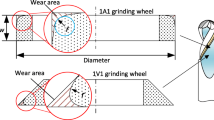Abstract
Helical groove is one of the key structures of end mills. Its grinding process is the hardest and most time-consuming in end mill machining. According to the practical groove-grinding process, a Boolean method to simulate the groove-grinding process is proposed in this paper. The groove model is obtained with the known wheel geometry by a sequence of Boolean operations. Accordingly, the wheel used to machine a desired groove is deduced with the similar method. Based on the Boolean operation results and principles of differential geometry, contact lines of the wheel and groove are illustrated and calculated to optimize the groove-grinding process. Wheel positions relative to the blank are described by a sequence of mathematical coordinates. Wheel profile expressions are built with the corresponding transformation matrixes including groove geometry transformation matrix, cutter tip transformation matrix, and start processing position transformation matrix. Some simulated examples are included to illustrate the presented method.
Similar content being viewed by others
References
Ehmanna KF, Devries MF (1990) Grinding wheel profile definition for the manufacture of drill flutes. CIRP Ann Manuf Technol 39:153–156
Kang SK, Ehmann KF, Lin C (1997) A CAD approach to helical groove machining. Part 2: numerical evaluation and sensitivity analysis. Int J Mach Tools Manuf 37:101–117
Wang LM, Chen ZC (2014) A new CAD/CAM/CAE integration approach to predicting tool deflection of end mills. Int J Adv Manuf Technol 72(9–12):1677–1686
Berbinschi S, Teodor VG, Oancea N (2012) 3D graphical method for profiling tools that generate helical surfaces. Int J Adv Manuf Technol 60:505–512
Berbinschi S, Teodor V, Oancea N (2012) A study on helical surface generated by the primary peripheral surfaces of ring tool. Int J Adv Manuf Technol 61:15–24
Teodor VG, Popa I, Oancea N (2010) The profiling of end mill and planing tools to generate helical surfaces known by sampled points. Int J Adv Manuf Technol 51:439–452
Kaldor S, Rafael AM, Messinger D (1988) On the CAD of profiles for cutters and helical flutes-geometrical aspects. CIRP Ann Manuf Technol 37:53–56
Pham TP, Ko SL (2010) A manufacturing model of an end mill using a five -axis CNC grinding machine. Int J Adv Manuf Technol 48:461–472
Ko SL (1994) Geometrical analysis of helical flute grinding and application to end mill. Trans NAMRI/SME 22:165–172
Lin SW, Lai HY (2001) A mathematical model for manufacturing ball-end cutters using a two-axis NC machine. Int J Adv Manuf Technol 17:881–888
Lin SW (2001) Study on the 2-axis NC machining of a toroid-shaped cutter with a constant angle between the cutting edge and the cutter axis. J Mater Process Technol 115(3):338–343
Chen WF, Lai HY, Chen CK (2001) A precision tool model for concave cone-end milling cutters. Int J Adv Manuf Technol 18:567–578
Chen JY, Lee BY, Chen CH (2008) Planning and analysis of grinding processes for end mills of cemented tungsten carbide. J Mater Process Technol 201:618–622
Puig A, Perez VL, Tost D (2003) 3D simulation of tool machining. Comput Graph 27(1):99–106
Tost D, Puig A, Perez VL (2004) Boolean operations for 3D simulation of CNC machining of drilling tools. Comput Aided Des 36(4):315–323
Mohan LV, Shunmugam MS (2004) CAD approach for simulation of generation machining and identification of contact lines. Int J Mach Tools Manuf 44:717–723
Kim JH, Park JW, Ko TJ (2008) End mill design and machining via cutting simulation. Comput Aided Des 40:324–333
Tandon P, Rajik KM (2009) Three dimensional modeling and finite element simulation of a generic end mill. Comput Aided Des 41(2):106–114
Author information
Authors and Affiliations
Corresponding author
Rights and permissions
About this article
Cite this article
Li, G., Sun, J. & Li, J. Process modeling of end mill groove machining based on Boolean method. Int J Adv Manuf Technol 75, 959–966 (2014). https://doi.org/10.1007/s00170-014-6187-7
Received:
Accepted:
Published:
Issue Date:
DOI: https://doi.org/10.1007/s00170-014-6187-7



